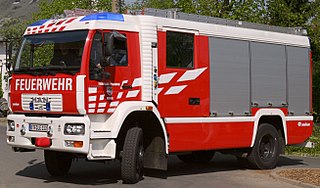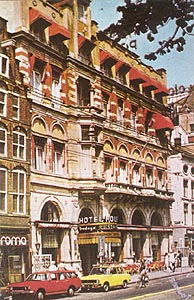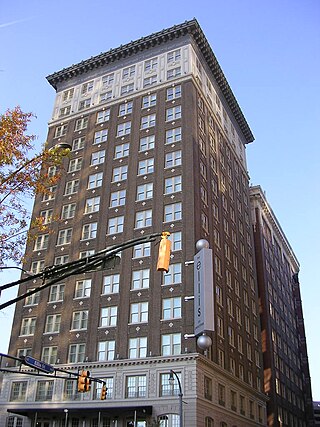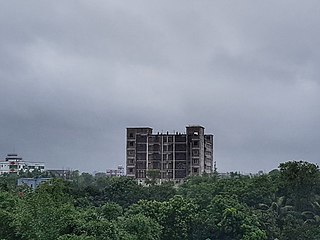
A firefighter is a first responder trained in firefighting, primarily to control and extinguish fires that threaten life and property, as well as to rescue persons from confinement or dangerous situations. Male firefighters are sometimes referred to as firemen.

The New York City Fire Department, officially the Fire Department of the City of New York (FDNY) is the full-service fire department of New York City, serving all five boroughs. The FDNY is responsible for providing Fire Suppression Services, Specialized Hazardous Materials Response Services, Emergency Medical Response Services and Specialized Technical Rescue Services in the entire city.

Garrett Augustus Morgan Sr. was an American inventor, businessman, and community leader. His most notable inventions were a type of three-way traffic light, and a protective 'smoke hood' notably used in a 1916 tunnel construction disaster rescue. Morgan also discovered and developed a chemical hair-processing and straightening solution. He created a successful company called "G. A. Morgan Hair Refining Company" based on his hair product inventions along with a complete line of haircare products and became involved in the civic and political advancement of African Americans, especially in and around Cleveland, Ohio.

The Triangle Shirtwaist Factory fire in the Greenwich Village neighborhood of Manhattan, New York City, on Saturday, March 25, 1911, was the deadliest industrial disaster in the history of the city, and one of the deadliest in U.S. history. The fire caused the deaths of 146 garment workers—123 women and girls and 23 men—who died from the fire, smoke inhalation, falling, or jumping to their deaths. Most of the victims were recent Italian or Jewish immigrant women and girls aged 14 to 23; of the victims whose ages are known, the oldest victim was 43-year-old Providenza Panno and the youngest were 14-year-olds Kate Leone and Rosaria "Sara" Maltese.

On Monday, December 1, 1958, a fire broke out at Our Lady of the Angels School in Chicago, Illinois, shortly before classes were to be dismissed for the day. The fire originated in the basement near the foot of a stairway. The elementary school was operated by the Archdiocese of Chicago and had an enrollment of approximately 1600 students. A total of 92 pupils and three nuns ultimately died when smoke, heat, fire, and toxic gases cut off their normal means of egress through corridors and stairways. Many more were injured when they jumped from second-floor windows which, because the building had a raised basement, were nearly as high above ground as a third floor would be on level ground, approximately 25 feet (7.6 m).

A PASS device, also known as a distress signal unit (DSU) or ADSU, is a personal safety device used primarily by firefighters entering a hazardous or "immediately dangerous to life and health" (IDLH) environment such as a burning building. The PASS device sounds a loud (95 decibel) audible alert to notify others in the area that the firefighter is in distress. On a fireground, the sound of an activated PASS device indicates a true emergency and results in an immediate response to rescue the firefighters in distress. In the United States, the National Fire Protection Association sets standards for PASS devices in NFPA 1982.

The Feuerwehr is a number of German fire departments. The responsible bodies for operating and equipping fire departments are the German communities ("Gemeinden") and cities ("Städte"). By law, they are required to operate fire-fighting forces. In cities, this is usually performed by the Fire Prevention Bureau, one of the higher-ranking authorities.

The Port Authority of New York and New Jersey Police Department, or Port Authority Police Department (PAPD), is a law enforcement agency in New York and New Jersey, the duties of which are to protect and to enforce state and city laws at all the facilities, owned or operated by the Port Authority of New York and New Jersey (PANYNJ), the bi-state agency running airports, seaports, and many bridges and tunnels within the Port of New York and New Jersey. Additionally, the PAPD is responsible for other PANYNJ properties including three bus terminals, the World Trade Center in Lower Manhattan, and the PATH train system. The PAPD is the largest transit-related police force in the United States.

For centuries, firefighters have worn helmets to protect them from heat, cinders and falling objects. Although the shape of most fire helmets has changed little over the years, their composition has evolved from traditional leather to metals, to composite helmets constructed of lightweight polymers and other plastics.

The Grover Shoe Factory disaster was an industrial explosion, building collapse and fire that killed 58 people and injured 150 when it leveled the R. B. Grover shoe factory in Brockton, Massachusetts on March 20, 1905. Following a boiler explosion, the four-story wooden building collapsed and the ruins burst into flames, incinerating workers trapped in the wreckage.

The September 11 attacks were the deadliest terrorist attacks in human history, causing the deaths of 2,996 people, including 2,977 victims and 19 hijackers who committed murder–suicide. Thousands more were injured, and long-term health effects have arisen as a consequence of the attacks. New York City took the brunt of the death toll when the Twin Towers of the World Trade Center complex in Lower Manhattan were attacked, with an estimated 1,600 victims from the North Tower and around a thousand from the South Tower. Two hundred miles southwest in Arlington County, Virginia, another 125 were killed in the Pentagon. The remaining 265 fatalities included the ninety-two passengers and crew of American Airlines Flight 11, the sixty-five aboard United Airlines Flight 175, the sixty-four on American Airlines Flight 77 and the forty-four who boarded United Airlines Flight 93. The attack on the World Trade Center's North Tower alone made the September 11 attacks the deadliest act of terrorism in human history.

The Brown Building is a ten-story building that is part of the campus of New York University (NYU), which owns it. It is located at 23–29 Washington Place, between Greene Street and Washington Square East in the Greenwich Village neighborhood of Manhattan, New York City, and is best known as the location of the Triangle Shirtwaist Factory fire of March 25, 1911, which killed 146 people. The Triangle Fire Memorial is now located there.

The 1913 Binghamton factory fire occurred on July 22, 1913, on the premises of the Binghamton Clothing Company, in Binghamton, New York. It destroyed the Wall Street building in less than 20 minutes, killing 31 of the more than 100 people inside. Though not as deadly as the Triangle Shirtwaist Factory fire in 1911, it put even more pressure on New York officials to strengthen life safety codes, increase funding for more inspectors, and increase penalties for violations.

Firefighting in the United States dates back to the earliest European colonies in the Americas. Early firefighters were simply community members who would respond to neighborhood fires with buckets. The first dedicated volunteer fire brigade was established in 1736 in Philadelphia. These volunteer companies were often paid by insurance companies in return for protecting their clients.

The Hotel Polen fire occurred on 9 May 1977 in Amsterdam, the Netherlands. The conflagration destroyed the Hotel Polen, a five-story hotel in the centre of the city which had been built in 1891, as well as the furniture store on the ground level and a nearby bookstore. Many of the tourists staying at the hotel jumped to their deaths trying to escape the flames. Upon their arrival, the fire department used a life net to help people escape, but not everyone could be saved. The incident resulted in 33 deaths and 21 severe injuries. The cause of the fire is unknown. In 1986, the Polish-born artist Ania Bien created a photographic installation based on the fire which compared it to the Holocaust.

The Winecoff Hotel fire, of December 7, 1946, was the deadliest hotel fire in American history, killing 119 hotel occupants, including the hotel's original owners. Located at 176 Peachtree Street in Atlanta, Georgia, the Winecoff Hotel was advertised as "absolutely fireproof". While the hotel's steel structure was indeed protected against the effects of fire, its interior finishes were combustible and the building's exit arrangements consisted of a single stairway serving all fifteen floors. All of the hotel's occupants above the fire's origin on the third floor were trapped, and the fire's survivors either were rescued from upper-story windows or jumped into nets held by firemen.

The 2012 Dhaka garment factory fire broke out on 24 November 2012, in the Tazreen Fashion factory in the Ashulia district on the outskirts of Dhaka, Bangladesh. At least 117 people were confirmed dead in the fire, and over 200 were injured, making it the deadliest factory fire in the nation's history. The cause of the fire was not determined. It was initially presumed to be caused by an electrical short circuit, the cause of 80% of factory fires in Bangladesh. A widely criticized government report alleged an act of "sabotage", without identifying who committed it or why. This fire and others similar to it have led to numerous proposed reforms in workers' rights and safety laws in Bangladesh.
A fire began at a budget hotel in Central Delhi, the Hotel Arpit Palace, in the Karol Bagh area of the city, at around 4.30am on 12 February 2019, killing at least 17 people. The fire went through all floors of the hotel; people were seen jumping from it.

The Berlin Fire Brigade is the fire and emergency medical service for Berlin, Germany. As well as firefighting, the Berlin Fire Brigade provides fire prevention, technical rescue services, emergency medical services, and assistance in case of chemical, biological, radioactive and nuclear hazards.






















